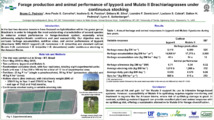Forage production and animal performance of Ipyporã and Mulato II Brachiariagrasses under continuous stocking.
Forage production and animal performance of Ipyporã and Mulato II Brachiariagrasses under continuous stocking.
Autoria: PEDREIRA, B. C. e; CARVALHO, A. P.; PARAISO, I.; SILVA, D.; DOMICIANO, L. F.; CABRAL, L.; PEREIRA, D. H.; SOLLENBERGER, L. E.
Resumo: In the last two decades breeders have focused on hybridization within the grass genus Brachiaria in order to integrate the most outstanding characteristics of several species to enhance animal performance in forage-livestock system, especially when addressing edaphoclimatic conditions and pest susceptibility. The objective of this study was to compare herbage accumulation, nutritive value, and animal performance of ?Ipyporã? [B. ruziziensis Germ. & Evrard × B. brizantha (Hochst. ex A. Rich.) Stapf] and ?Mulato II? (B. ruziziensis × B. brizantha× B. decumbens Stapf) brachiariagrasses in the Brazilian Amazon biome. All experimental units were continuously stocked using a variable stocking rate from May 2016 to May 2018. Herbage accumulation (HA) was greater in Mulato II (17,370 kg DM ha?1) than Ipyporã (14,930 kg DM ha?1), resulting in 25 and 23% greater stocking rate (SR) and gain ha?1 than Ipyporã, respectively. Herbage allowance did not differ between grasses (averaging 6.52 kg DM kg?1 BW). The crude protein (CP), neutral (NDF), and acid (ADF) detergent fiber concentrations did not differ between cultivars (P > 0.05). Greater annual HA and gain ha-1 for Mulato II support its use in intensive forage-based systems. However, susceptibility of Mulato II to spittlebug requires regular monitoring and treatment in regions like the Amazon biome, where risk of spittlebug damage is great. In contrast, spittlebug-resistant Ipyporã can provide excellent plant and animal response with no spittlebug risk, offering a sustainable alternative to Mulato II for forage diversification.
Ano de publicação: 2020
Tipo de publicação: Resumo em anais e proceedings
Unidade: Embrapa Agrossilvipastoril
Palavras-chave: Amazonia, Animal performance, BRS RB331, Brachiaria Ruziziensis, Forage, Forragem, Ipyporã, Mato Grosso, Mulato II, Sinop-MT
Observações
1 - Por padrão são exibidas publicações dos últimos 20 anos. Para encontrar publicações mais antigas, configure o filtro ano de publicação, colocando o ano a partir do qual você deseja encontrar publicações. O filtro está na coluna da esquerda na busca acima.
2 - Para ler algumas publicações da Embrapa (apenas as que estão em formato ePub), é necessário ter, no celular ou computador, um desses softwares gratuitos. Sistemas Android: Google Play Livros; IOS: iBooks; Windows e Linux: software Calibre.
Acesse outras publicações
Acesse a Base de Dados da Pesquisa Agropecuária (BDPA) para consultar o acervo completo das bibliotecas da Embrapa.

